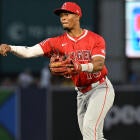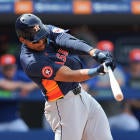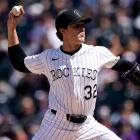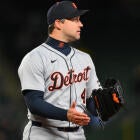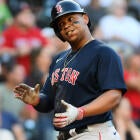TNSTAAPP
There's No Such Thing As a Pitching Prospect.
If you haven't memorized these words yet, you're behind the curve, because smart baseball fans have known them for years. It means, of course, exactly what it sounds like: Because they're so unpredictable and volatile, there's just no such thing as a guarantee with any young pitcher.
The point is to highlight how risky even those with the shiniest pedigrees can be -- just ask anyone who invested heavily into Tyler Glasnow or Lucas Giolito over the past few years. Injuries and underperformance are constants with nearly all pitchers.
However, the logic works backward, too. Pitchers are so unpredictable that when they seem to come out of nowhere flashing elite potential, pedigree only matters so much. Luis Severino didn't have the pedigree of Glasnow or Giolito, just to name a few, but what he's done this season renders all prospect-based analysis moot. He's for real.
Luis Castillo isn't quite at the same point as Severino, but based on what we've seen from him in his first five major-league starts, I'm just about ready to throw away all those middling scouting reports from his minor-league career.
What did those scouting reports have to say? Well, before the season, BaseballProspectus.com had Castillo ranked as the Marlins' No. 2 overall prospect prior to a trade to the Reds that landed them Dan Straily. Under the "Risks" sub-heading, Steve Givarz had this to say about Castillo:
"Was older for High-A, secondary pitches need to become more consistent for an everyday big-league spot, lack of consistent changeup could force a bullpen move sooner rather than later as a pitcher."
The fastball is the headline offering, as Castillo ranks behind only Noah Syndergaard among starters in average fastball velocity, at 97.9 mph. The former reliever has proven capable of holding that velocity deep into games, averaging 97-plus in the fifth, sixth and seven innings to date. It's a true plus pitch, and a nice place to start building from.
However, as the scouting report implies, in the minors, that wasn't necessarily enough, as Castillo sported a 2.26 ERA but struck out just 7.0 batters per nine innings in 2016. As hard as he could throw, he seemingly wasn't fooling minor-leaguers with his softer stuff. That's a recipe for a one-way trip to the bullpen before long.
Check out this clip from his very first major-league start -- his first four pitches in the majors ever -- (courtesy of the indispensable PitcherList.com:
Hold up.
Did you watch that clip? All the way to the end?
Castillo starts Trea Turner with three fastballs at 99, 99, and 100 mph. Just like the scouting report.
But there, at the end. Did you see it? That's a heck of a breaking ball, one that makes Turner -- a pretty good hitter, mind you -- look awfully foolish. And that might not even be Castillo's best secondary pitch at this point!
Five starts into his MLB career, Castillo's secondary pitches have been pretty much unhittable. Opposing batters are hitting just .111 against his changeup, and .063 with his slider, with no extra-base hits allowed on either pitch (per BrooksBaseball.net). His swinging strike rates on both have been healthy, as he picks up a whiff 22.2 percent of the time with his changeup, and 17.8 percent of the time with his slider; both are well above the league average for their pitch type.
And he hasn't been afraid to throw his secondaries either. His 64.0 percent fastball usage is higher than average, but it's comparable to fellow flamethrowers like Gerrit Cole (59.0 percent), Michael Fulmer (60.6), and Robbie Ray (59.2). He's not Masahiro Tanaka or Rich Hill, but Castillo has proven willing to trust his secondary pitches, and the results show that the pitches certainly deserve that trust.
Castillo's results don't necessarily scream "elite" yet, but there's important context here. His 3.41 ERA and 1.345 WHIP are OK -- certainly worth owning, on the surface, especially coming with an elite strikeout rate. However, Castillo has yet to face even a decent matchup, as his game log shows:
That is the No. 2, 8, 5, 7 and 2 offenses all right in a row to open his career, and Castillo has yet to have a really bad start. Four earned runs in 5 2/3 innings in Coors Field is the worst we've seen from him yet, and it still came with eight strikeouts and a whopping 17 swinging strikes in the thin air in Denver.
Maybe Castillo won't turn into an ace. Maybe we're just seeing him catching the league off-guard, and the scouting reports from the minors will eventually catch up to him. His minor-league track record before this season certainly doesn't suggest this kind of strikeout rate is sustainable, and the scouts who got a look at him before this came away relatively unimpressed.
However, I don't know how you could look at what Castillo has done in his brief introduction and come away anything but impressed. Maybe the league catches up to him, but that might be a tall order. With that 100 mph heat and multiple potential plus pitches, Castillo might have what it takes to stick.
That's no guarantee -- remember, "TNSTAAPP" -- but I'm willing to bet on one thing: you've got a less impressive pitcher on your roster. With Castillo available in 40 percent of CBSSports.com leagues, adding him should still be a priority.
![[object Object] Logo](https://sportshub.cbsistatic.com/i/2020/04/22/e9ceb731-8b3f-4c60-98fe-090ab66a2997/screen-shot-2020-04-22-at-11-04-56-am.png)









